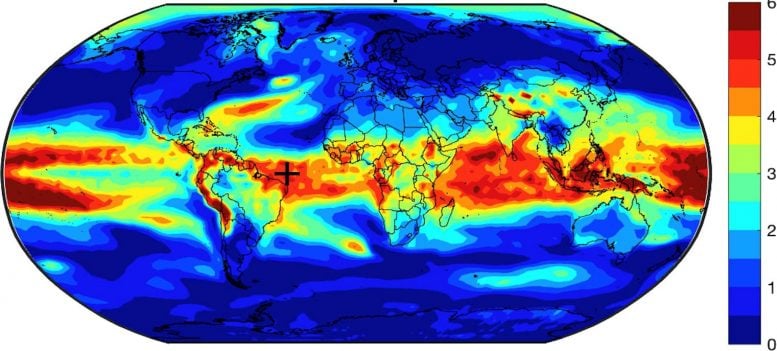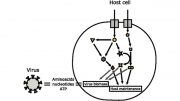
This map of the Earth shows the spatial pattern of temperature variance by percentage. The most variance is seen in the tropics with less at the poles. Credit: Daniel J. Brouillette. Penn State
Volcanic eruptions, not natural variability, were the cause of an apparent “Atlantic Multidecadal Oscillation,” a purported cycle of warming thought to have occurred on a timescale of 40 to 60 years during the pre-industrial era, according to a team of climate scientists who looked at a large array of climate modeling experiments.
The result complements the team’s previous finding that what had looked like an “AMO” occurring during the period since industrialization is instead the result of a competition between steady human-caused warming from greenhouse gases and cooling from more time-variable industrial sulfur pollution.
“It is somewhat ironic, I suppose,” said Michael E. Mann, distinguished professor of atmospheric science and director, Earth System Science Center, Penn State. “Two decades ago, we brought the AMO into the conversation, arguing that there was a long-term natural, internal climate oscillation centered in the North Atlantic based on the limited observations and simulations that were available then, and coining the term ‘AMO.’ Many other scientists ran with the concept, but now we’ve come full circle. My co-authors and I have shown that the AMO is very likely an artifact of climate change driven by human forcing in the modern era and natural forcing in pre-industrial times.”
The researchers previously showed that the apparent AMO cycle in the modern era was an artifact of industrialization-driven climate change, specifically the competition between warming over the past century from carbon pollution and an offsetting cooling factor, industrial sulfur pollution, that was strongest from the 1950s through the passage of the Clean Air Acts in the 1970s and 1980s. But they then asked, why do we still see it in pre-industrial records?
Their conclusion, reported today (March 5, 2021) in Science, is that the early signal was caused by large volcanic eruptions in past centuries that caused initial cooling and a slow recovery, with an average spacing of just over half a century. The result resembles an irregular, roughly 60-year AMO-like oscillation.
“Some hurricane scientists have claimed that the increase in Atlantic hurricanes in recent decades is due to the uptick of an internal AMO cycle,” said Mann. “Our latest study appears to be the final nail in the coffin of that theory. What has in the past been attributed to an internal AMO oscillation is instead the result of external drivers, including human forcing during the industrial era and natural volcanic forcing during the pre-industrial era.”
The researchers looked at state-of-the-art climate models both for preindustrial times over the past thousand years where external factors such as solar and volcanic drivers were used, and unforced, “control” simulations where no external drivers were applied and any changes that happen are internally generated. When they looked at simulations for the short, 3- to 7-year El Niño Southern Oscillation (ENSO) cycles, they found that these cycles occurred in the models without adding forcing by climate change, volcanic activity, or anything else.
However, when they looked for the AMO, it did not occur in the unforced model and only appeared in modern times using climate change variables as forcing and in preindustrial times with forcing by volcanic eruptions.
“The models do show intrinsic internal oscillations on a 3- to 7-year time scale characteristic of the established El Niño phenomenon, but nothing on the multi-decadal scale that would be the AMO,” said Byron A. Steinman, associate professor of Earth and environmental sciences, University of Minnesota Duluth, who was also on the project. “What we know is an oscillation like El Niño is real, but the AMO is not.”
Mann suggested that while some influential scientists continue to dismiss certain climate change trends as the result of a supposed internal AMO climate cycle, the best available scientific evidence does not support the existence of such a cycle.
Reference: “Multidecadal climate oscillations during the past millennium driven by volcanic forcing” by Michael E. Mann, Byron A. Steinman, Daniel J. Brouillette and Sonya K. Miller, 4 March 2021, Science.
DOI: 10.1126/science.abc5810
Other researchers from Penn State on this project were Daniel J. Brouillette and Sonya K. Miller, both researchers in meteorology.
The National Science Foundation partially funded this research.









Some of the “increased” hurricane activity is due to satellite surveillance of the oceans; major storms of yesteryear that didn’t make landfall never got names. Also, the criteria for what gets named now includes non-events like last year’s storms Arthur, Bertha, Dolly, Eduardo, Fay, Gonzalo, Josephine, Kyle, Omar, Vicky, Wilfred, Beta, and Gamma. Notably, the busiest year on record was neither the costliest or the most deadly (the most deadly seasons were pre-WW2).
Notably, no major storms hit the US from 2005 to 2015, an unprecedented hiatus (despite rising CO2 levels). Looking at the historical record (per Wikipedia), during the cool periods, such as 1950-1970, hurricane activity diminished; since the current warming began, circa 1980, it’s increased. The warming from 1850-1890 also saw increased hurricane activity causing tens of thousands of deaths (CO2 not a factor then). It remains to be seen to what extent CO2 warming will override the next cooling cycle, due to begin perhaps during the next 10 years. Our understanding of climate change remains subject to revision, as Dr Mann concedes in the article above.
100% BS….. At no point is anyone addressing the massive amount of solar radiation being dumped into the South Atlantic Anomaly… All that energy has to go somewhere..
What a coincidence that random volcanic eruptions provided a pseudo-periodic forcing to create an oscillation (AMO) that fooled the best minds in climatology (Including the authors of this paper!), and just when necessary, anthropogenic forcing came along and helped keep the ‘swing’ going. This is all based on computer models that are known to run warm, are highly parameterized with subjective assessments of a crucial forcing (clouds), and are tuned (fitted) to past temperature records.
The claim, “Our latest study appears to be the final nail in the coffin of that theory,” is probably premature, and certainly lacking in humility.